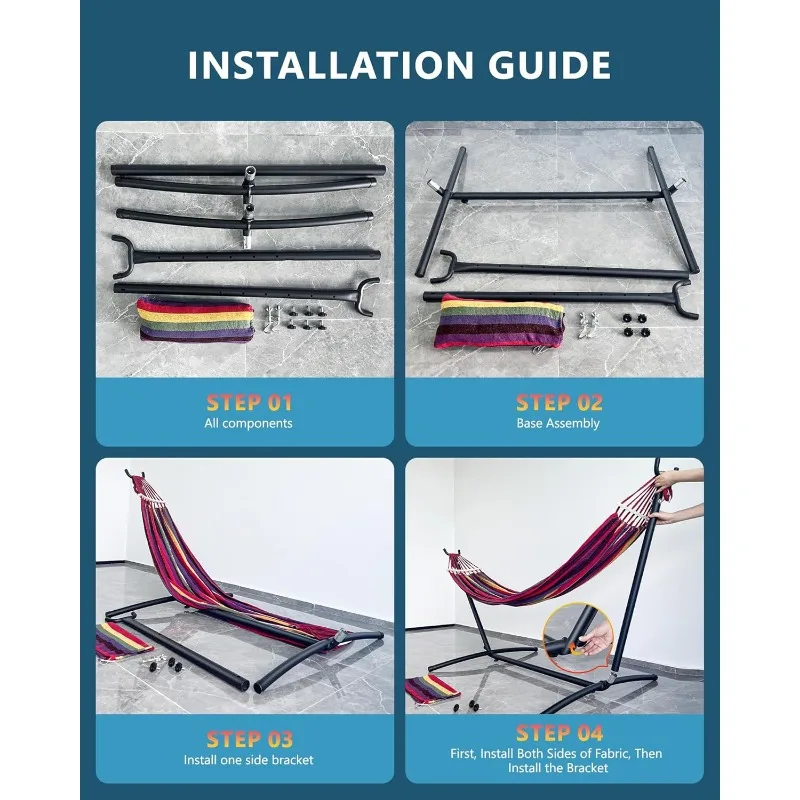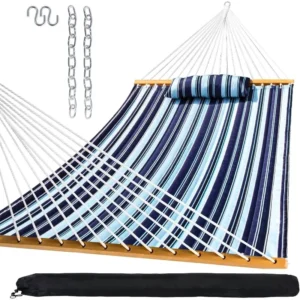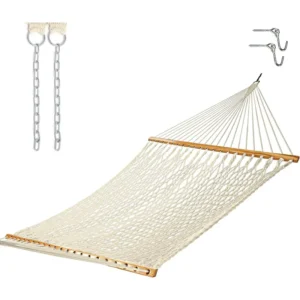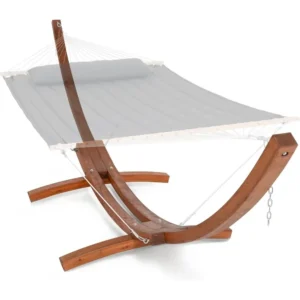Understanding Fabric Hammock Weight Capacity Basics
When shopping for a fabric hammock, one of the most important specifications to understand is its weight capacity. This isn’t just about whether it will hold you—it’s about safety, durability, and getting the relaxing experience you deserve.
Weight capacity for hammocks refers to the maximum static weight the hammock can safely support when properly installed. Static weight is the steady, non-moving load placed on the hammock, which differs from dynamic weight that occurs during movement like swinging or getting in and out.
Understanding hammock weight limits matters for several important reasons:
- Safety: Exceeding a hammock’s weight capacity can lead to sudden failure, potentially causing injuries from falls
- Longevity: Regularly loading a hammock near or beyond its limits shortens its lifespan dramatically
- Comfort: A hammock operating within its intended weight range provides better support and comfort
Manufacturers determine weight capacity through various testing methods, including applying progressive weight loads until failure points emerge. This process helps identify the maximum safe capacity with appropriate safety margins built in.
It’s crucial to remember that a hammock’s weight capacity applies to the entire system—not just the fabric portion. The proper placement of your hammock affects how weight gets distributed throughout the system. Even the strongest fabric can fail if your suspension points, hardware, or anchors aren’t equally robust. Understanding the general principles of hammock weight capacity helps you make safer choices for your relaxation needs.
Typical Weight Capacities of Different Fabric Hammocks
Fabric hammocks come in various sizes and designs, each with different weight capacities suited to specific needs. Understanding these typical ranges helps you choose the right hammock for your situation.
Standard Weight Capacity Ranges
- Single hammocks: 250-400 pounds (113-181 kg)
- Double/two-person hammocks: 400-550 pounds (181-249 kg)
- Family/XL hammocks: 500-1000 pounds (227-453 kg)
Camping hammocks and backyard hammocks often have different weight capacities despite similar appearances. Camping hammocks tend to prioritize lightweight materials that may sacrifice some weight capacity, while leisure hammocks for backyard use often use heavier, more durable fabrics with higher capacity ratings.
When interpreting manufacturer specifications, remember that stated weight capacities typically include a safety margin. However, for your own safety, you should add your own buffer. A good rule of thumb is to choose a hammock rated for at least 20% more than your anticipated load.
| Hammock Type | Typical Weight Capacity | Best Use Case |
|---|---|---|
| Ultralight Camping | 250-300 lbs (113-136 kg) | Solo backpacking |
| Standard Single | 300-400 lbs (136-181 kg) | Everyday relaxation |
| Double | 400-550 lbs (181-249 kg) | Couples or extra space |
| Family/XL | 500-1000+ lbs (227-453+ kg) | Multiple users or maximum security |
For users who need higher weight capacities, specialized heavy-duty hammock sets offer reinforced construction and materials designed specifically for larger loads. When considering hammocks for two people, remember that hammock width for two-person use directly relates to both comfort and how the weight gets distributed.
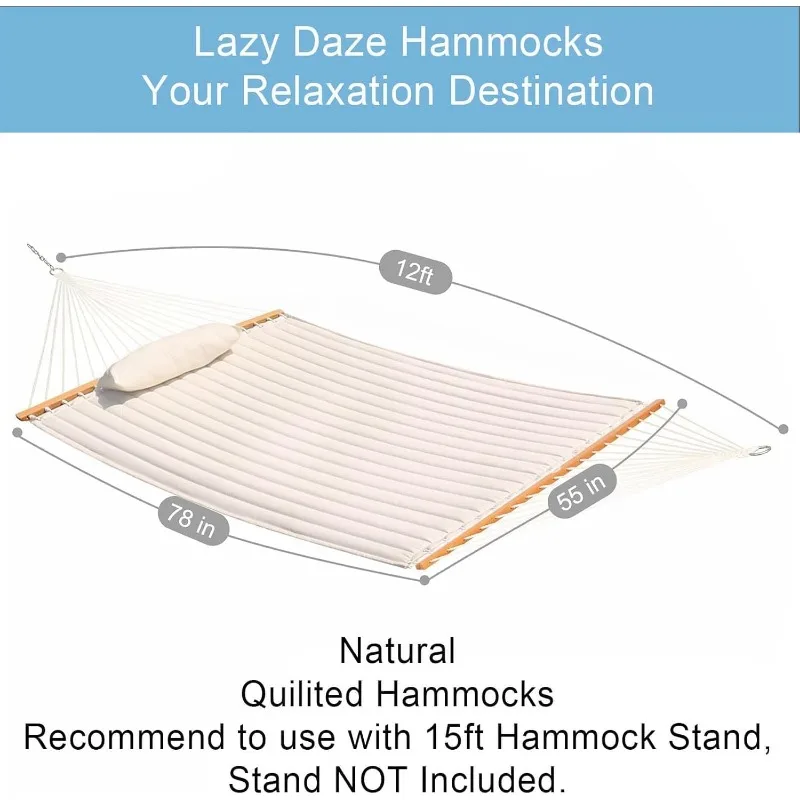
Critical Factors That Determine a Hammock’s Weight Limit
Understanding what makes a hammock strong helps you make better purchasing decisions and use your hammock safely. Several key factors determine how much weight a fabric hammock can hold:
Fabric Material and Quality
The type of fabric is perhaps the most obvious factor affecting weight capacity:
- Nylon: Lightweight with excellent strength-to-weight ratio; common in camping hammocks
- Polyester: Good UV resistance and durability; widely used in outdoor leisure hammocks
- Cotton: Comfortable but generally lower strength than synthetic options
- Canvas: Very durable but heavy; often used in high-capacity hammocks
Fabric density matters significantly. For synthetic fabrics, higher denier numbers (such as 210D vs 70D nylon) indicate thicker, stronger materials. For cotton and canvas, higher thread counts typically mean stronger fabric.
Many premium hammocks use double-layer construction, effectively doubling the weight capacity compared to single-layer designs made from the same material.
Construction and Design Elements
How a hammock is put together dramatically affects its strength:
- Stitching: Triple-stitched seams offer significantly more strength than single-stitched ones
- Reinforcement points: Extra material or specialized stitching at stress points (particularly where the suspension attaches)
- Design style: Gathered-end hammocks distribute weight differently than spreader bar hammocks
- Edge finishing: Reinforced edges resist tearing and stretching
The choice between spreader bar hammock designs and gathered-end styles affects not just comfort but weight distribution. Spreader bars create a flatter surface but concentrate stress at fewer points, while gathered ends often distribute weight more evenly across the fabric.
Suspension System Components
Even the strongest fabric will fail if the suspension can’t hold the same weight:
- Ropes and straps: Material thickness and quality determine breaking strength
- Hardware: Carabiners, rings, and hooks should match or exceed the fabric’s capacity
- Connection points: How the suspension attaches to the fabric (whipping, channel, etc.) can be a weak link
- Weight rating compatibility: All components should have compatible weight ratings
Many hammock failures occur not in the fabric but at connection points or in the suspension system. Higher-quality fabric hammock sets integrate these components with matching capacity ratings.
Manufacturing Quality and Brand Reputation
Not all hammocks are created equal, even when using similar materials:
- Quality control: Consistency in stitching, materials, and assembly
- Testing standards: How rigorously the manufacturer tests finished products
- Brand reputation: Established brands typically have more consistent quality standards
These factors combine to determine the ultimate weight capacity of any fabric hammock. Understanding them helps you assess hammocks beyond just looking at the stated weight limit.
How to Find Your Hammock’s Specific Weight Limit
Knowing exactly how much weight your particular hammock can hold is essential for safe use. Here’s where to find this critical information:
Official Sources of Weight Capacity Information
Start by checking these locations:
- Product tags: Permanent tags sewn into the hammock often list weight capacity
- Packaging: Original boxes and packaging materials typically state weight limits
- Instruction manuals: These provide the most detailed specifications
- Manufacturer websites: Product pages list official specifications
- Customer service: Direct contact with the manufacturer can provide definitive answers
When examining tags or packaging, look for clear statements like “Maximum weight capacity” or “Weight limit.” This information is typically displayed prominently as it’s a key safety specification.
When Weight Capacity Isn’t Listed
If you can’t find official capacity information:
- Search for your exact model online to find specifications
- Contact the manufacturer directly with your model number
- Look for similar products from the same manufacturer to estimate capacity
- Assess the hammock construction using the factors discussed earlier
For handmade or unmarked hammocks, be especially cautious. Consider the material thickness, stitching quality, and suspension components to make an educated guess—but always err on the side of caution.
Remember that your hammock system is only as strong as its weakest component. Even if the fabric can hold 500 pounds, the proper installation and safety requirements must be followed to maintain that capacity. The weakest element—whether fabric, stitching, suspension, or anchor points—determines your actual safe weight limit.
The Impact of Suspension Systems on Weight Capacity
While the hammock fabric itself might be strong, the suspension system often determines the true weight capacity of your setup. Understanding these components ensures your relaxation remains safe and secure.
The Weakest Link Principle
A hammock system can only support as much weight as its weakest component. In many cases, this turns out to be the suspension system rather than the fabric itself. Common suspension components include:
- Ropes and cords: Natural fibers typically have lower strength than synthetic options like polyester or nylon
- Webbing straps: Wider straps (1-2 inches) distribute weight better than thin ropes
- Chains: Provide high strength but add significant weight
- Carabiners and S-hooks: Quality varies dramatically between recreational and climbing-grade options
The material thickness directly impacts strength—a 1/4-inch polyester rope has significantly less breaking strength than a 1/2-inch rope of the same material.
Anchor Point Considerations
Even the strongest suspension system fails if attached to weak anchor points:
- Trees: Need to be healthy, mature, and at least 6-8 inches in diameter
- Posts: Should be deeply embedded in concrete for stability
- Hammock stands: Have specific weight ratings that must not be exceeded
Hammock stands deserve special attention as their weight capacities vary widely. Lightweight portable stands might support only 250-300 pounds, while heavy-duty options can hold 450-600 pounds or more. Proper stabilization of double hammock stands becomes increasingly important as you approach maximum weight capacity.
Hanging Technique Matters
How you hang your hammock significantly affects its effective weight capacity:
- Hanging angle: The optimal 30-degree angle from horizontal creates less stress than flatter angles
- Even tensioning: Uneven tension places disproportionate stress on one side
- Height adjustment: Lower hanging heights create less potential energy if failure occurs
A properly hung hammock at the correct angle can effectively support more weight than the same hammock hung incorrectly, even though the materials haven’t changed.

Safety Guidelines When Using Fabric Hammocks
Following proper safety guidelines ensures your hammock experience remains enjoyable and accident-free. Here are essential practices to keep in mind:
1. Respect Weight Limits with Safety Margins
Never exceed the manufacturer’s stated weight capacity. For added security, stay at least 15-20% below the maximum rating. This margin accounts for:
- Dynamic forces created during entry and exit
- Natural material degradation over time
- Manufacturing variations
- Unexpected stress from movement
2. Set Up Your Hammock Properly
Proper setup maximizes strength and stability:
- Hang your hammock with approximately a 30-degree angle from horizontal
- Ensure anchor points are at equal heights for balanced weight distribution
- Position the hammock 18-24 inches off the ground—high enough to avoid ground contact but low enough to minimize fall risk
- Check that all components are properly connected and secured
3. Perform Regular Inspections
Before each use, inspect your hammock for:
- Fabric integrity: Look for tears, thinning areas, or stretched sections
- Stitching condition: Check for loose, frayed, or broken threads, especially at load-bearing seams
- Suspension components: Examine for wear, fraying, or metal fatigue
- Connection points: Ensure all attachment points remain secure and undamaged
4. Use Special Caution with Multiple Users
When sharing a hammock:
- Verify the combined weight remains well under capacity limits
- Enter and exit one person at a time to avoid sudden weight shifts
- Distribute weight evenly across the fabric
- Avoid concentrating weight in the center
5. Avoid Dynamic Movements
Certain activities dramatically increase stress on hammock systems:
- Swinging aggressively
- Bouncing or jumping
- Standing in the hammock
- Sudden entries or exits
These dynamic movements can create forces several times greater than static weight.
Comprehensive safety practices should always be followed regardless of your hammock type. For those regularly accommodating two people, selecting appropriate double-person hammock sets designed specifically for multiple users provides added security.
Fabric Hammocks for Heavier Individuals
Everyone deserves to enjoy the comfort of a quality hammock regardless of size. Fortunately, manufacturers now offer specialized options designed specifically for higher weight capacities.
Features of High-Capacity Hammocks
High-capacity hammocks incorporate several key design elements:
- Reinforced fabrics: Double or triple-layered construction with higher denier ratings
- Superior stitching: Multiple rows of industrial-grade stitching, often with box-X patterns at stress points
- Wider dimensions: Extra width (typically 65-85 inches) distributes weight more effectively
- Heavy-duty suspension: Thicker ropes or straps with higher breaking strengths
- Enhanced connection points: Reinforced edge channels and attachment points
These specialized hammocks typically offer weight capacities ranging from 500-1000 pounds (227-453 kg), significantly higher than standard models.
The design of high-capacity hammocks also emphasizes comfort through superior weight distribution. Quilted fabric hammock designs often provide excellent support for heavier individuals due to their layered construction and reinforced stitching patterns.
When shopping for high-capacity options, expect to pay somewhat more than standard hammocks—the additional materials and reinforced construction necessarily increase production costs. However, this investment provides both safety and peace of mind.
Width becomes particularly important for larger individuals. A hammock that’s too narrow creates uncomfortable pressure points and reduces the effective weight capacity by concentrating stress. Look for widths of at least 4-5 feet for single users of larger size.
Extending Your Hammock’s Lifespan and Maintaining Capacity
Proper care and maintenance not only extend your hammock’s lifespan but also help preserve its weight-bearing capacity over time. Following these guidelines ensures your hammock remains safe and functional for years.
Storage Best Practices
How you store your hammock when not in use significantly affects its longevity:
- Store indoors in a cool, dry place when not in use for extended periods
- Hang hammocks loosely or fold them rather than compressing tightly
- Keep away from direct sunlight and moisture during storage
- Use a breathable storage bag rather than plastic containers
Cleaning Guidelines
Different fabrics require specific cleaning approaches:
- Cotton/Canvas: Hand wash with mild soap, rinse thoroughly, and air dry completely
- Nylon/Polyester: Can often be machine washed on gentle cycle with mild detergent
- All types: Never use bleach or harsh chemicals that can degrade fibers
Clean your hammock regularly to prevent dirt and oils from breaking down fibers over time.
Addressing Wear and Damage
Minor issues can become major problems if not addressed promptly:
- Repair small tears or holes immediately before they expand
- Replace frayed suspension ropes or straps before they fail
- Reinforce weakened stitching at the first sign of loosening
Environmental factors like UV radiation and moisture can significantly weaken hammock materials over time. Understanding whether you can safely leave a hammock outside helps prevent premature deterioration.
Signs that indicate it’s time to retire your hammock include:
* Widespread fabric thinning
* Multiple repairs in load-bearing areas
* Significant color fading (indicating UV damage)
* Persistent stretching that doesn’t recover
With proper care, a quality fabric hammock can maintain its full weight capacity for many seasons of enjoyment.
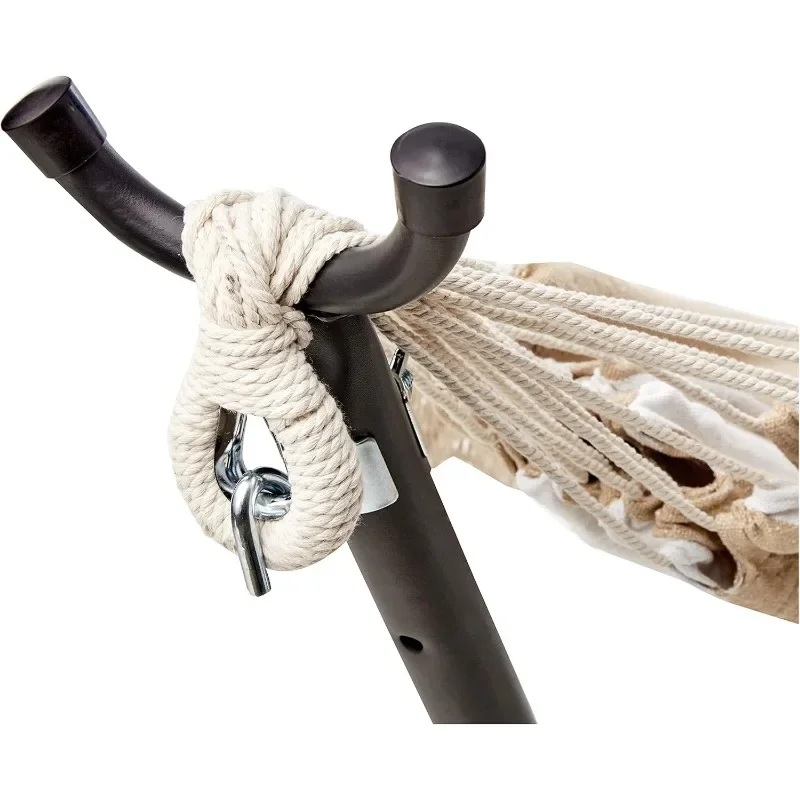
Comparing Fabric Hammocks to Other Hammock Types
Understanding how fabric hammocks compare to other styles helps you choose the best option for your needs, particularly regarding weight capacity and durability.
Weight Capacity Comparison
| Hammock Type | Typical Weight Capacity | Key Construction Features |
|---|---|---|
| Fabric (cotton/poly) | 300-550 lbs (136-249 kg) | Solid woven material, machine stitching |
| Rope | 275-450 lbs (125-204 kg) | Knotted or woven rope, more pressure points |
| Brazilian | 350-450 lbs (159-204 kg) | Tightly woven cotton, traditional craftsmanship |
| Mayan | 300-550 lbs (136-249 kg) | Hand-woven nylon strings, flexible construction |
| Camping (ultralight) | 250-400 lbs (113-181 kg) | Lightweight ripstop nylon, minimalist design |
Each hammock type distributes weight differently based on its construction. Fabric hammocks provide consistent support across their entire surface, while rope hammocks create a grid pattern that may concentrate pressure at intersection points.
Rope hammock sets often use thicker materials but have numerous potential failure points at knots or intersections. In contrast, fabric hammocks rely on the integrity of the weave and quality of stitching along fewer seams.
Traditional Mayan and Brazilian hammocks use specific weaving techniques that create remarkable strength while maintaining flexibility. These designs often stretch more than modern fabric hammocks but provide excellent adaptability to different body shapes.
Camping hammocks prioritize lightweight design, sometimes sacrificing maximum capacity, though premium models use high-tech materials to maintain strength while reducing weight.
Classic Wooden Stand Hammock Sets, Heavy Duty Hammock Sets
$1,061.68 Select options This product has multiple variants. The options may be chosen on the product pageHammock Sets with Canopy, Heavy Duty Hammock Sets
$286.31 Select options This product has multiple variants. The options may be chosen on the product pageDouble / Two Person Hammock Sets, Rope Hammock Sets
Double Traditional Cotton Rope Hammock with Extension Chains – 450 lbs Capacity for Backyard & Patio$292.98 Select options This product has multiple variants. The options may be chosen on the product pageHeavy Duty Hammock Sets, Wooden Arc Stand Hammock Sets
$878.66 Select options This product has multiple variants. The options may be chosen on the product page
Frequently Asked Questions About Hammock Weight Capacity
Can two people use a single hammock if under the weight limit?
Yes, two people can share a single hammock if their combined weight falls well below the stated capacity limit. However, even when within weight limits, single hammocks may feel cramped for two adults. The hammock should be wide enough to accommodate both users comfortably, and weight should be evenly distributed.
Is the hammock’s weight capacity affected by how you hang it?
Absolutely. The hanging angle significantly impacts effective weight capacity. The recommended 30-degree angle optimizes strength, while hanging too flat increases tension forces dramatically. Additionally, uneven hanging creates pressure points that reduce overall capacity.
What is the difference between static and dynamic weight capacity?
Static weight capacity refers to the maximum steady, non-moving weight a hammock can support. Dynamic weight capacity relates to forces created during movement, such as getting in or swinging. Dynamic forces can easily be 2-3 times greater than static weight, which is why staying well below maximum capacity is important.
How do manufacturers test weight capacity?
Most manufacturers test hammocks by gradually applying increasing static weight until identifying failure points. They then set rated capacities well below these failure points. Some also perform dynamic testing with mechanical simulation of entry/exit movements or use long-term stress tests to evaluate durability.
Which hammock materials have the highest weight capacities?
Generally, synthetic materials like nylon and polyester offer the highest strength-to-weight ratios. Heavy-duty cotton canvas provides excellent weight capacity but adds bulk. Double-layer constructions significantly increase capacity regardless of material choice.
Are spreader bar hammocks stronger than gathered-end designs?
Not necessarily. While spreader bar hammocks create a flatter surface, they place more concentrated stress on fewer points. Gathered-end designs often distribute weight more evenly across the fabric and suspension points. The construction quality and materials matter more than the basic design type.
What are the signs that a hammock is approaching its weight limit?
Warning signs include excessive stretching, creaking sounds, visible strain at stitching or attachment points, and noticeable sagging beyond normal. If you observe any of these indicators, exit the hammock carefully and reassess your setup or consider a higher-capacity option.
Proper hammock placement and location also affect weight distribution and the overall safety of your setup.
What Happens When You Exceed a Hammock’s Weight Capacity?
Understanding the consequences of exceeding weight limits helps emphasize why following guidelines is so important for both safety and product longevity.
Immediate Failure Scenarios
When weight limits are significantly exceeded, several types of failure can occur:
- Fabric tears: Usually begin at stress points near suspension connections
- Seam failure: Stitching breaks along load-bearing seams
- Suspension breakage: Ropes snap or hardware deforms under excessive load
- Hardware deformation: Carabiners, S-hooks, or rings can bend or break
- Stand collapse: Hammock stands can fold or tip when overloaded
These failures typically happen suddenly with little warning, creating fall risks and potential injury.
Gradual Degradation Effects
Even if catastrophic failure doesn’t occur immediately, regularly exceeding weight capacity causes:
- Progressive stretching: The fabric loses tension and develops excessive sag
- Weakened fibers: Microscopic damage accumulates in the fabric weave
- Stress at attachment points: Gradual widening of holes or tearing at suspension connections
- Reduced maximum capacity: Over time, the effective weight capacity actually decreases
- Shortened lifespan: Overall durability decreases significantly
A hammock that’s been regularly overloaded may appear functional but have hidden damage that could lead to sudden failure later.
Common Misconceptions
Several dangerous myths persist about hammock weight capacities:
- “The listed capacity is just a suggestion” – False! Manufacturers set these limits for safety reasons
- “Breaking in” a hammock by exceeding its capacity will make it stronger – False! This damages the materials
- “It held more weight before, so it’s fine” – False! Previous overloading weakens the hammock
Weight capacity should always be taken seriously. Choosing a hammock with capacity well above your needs provides both safety and longevity, ensuring you can enjoy your relaxation time with complete peace of mind.

